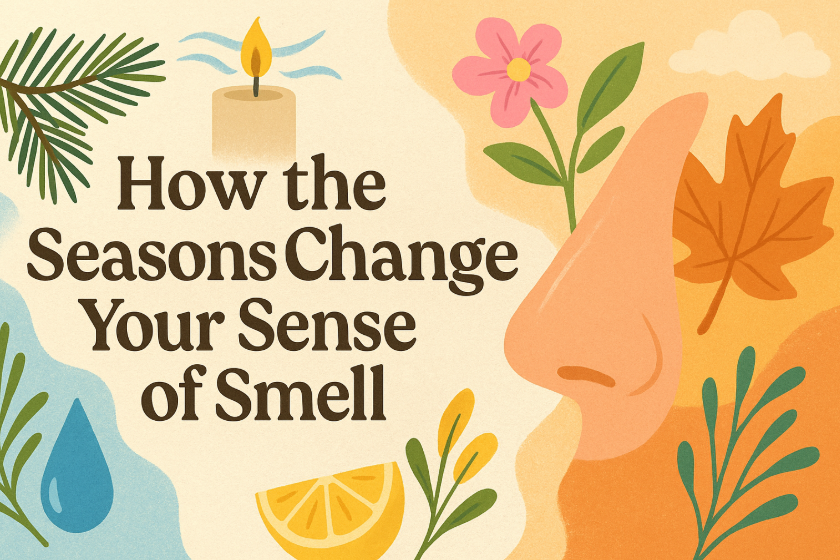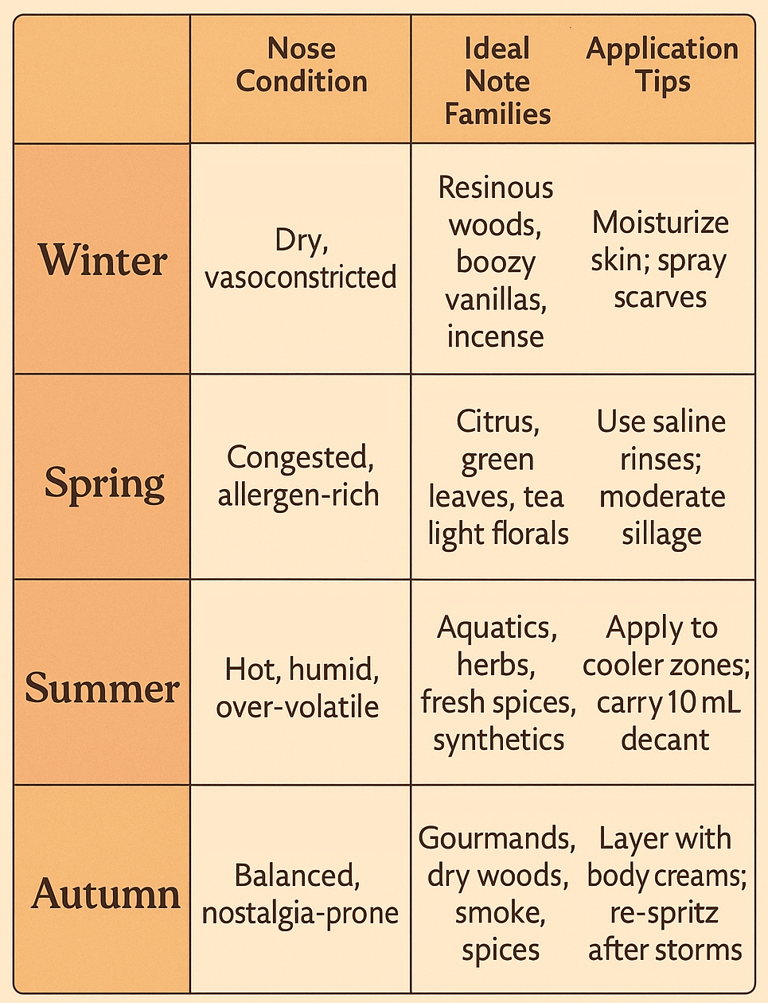How the Seasons Change Your Sense of Smell
Explore how humidity, temperature, and even seasonal allergies alter your olfactory perception, and how to choose scents accordingly.
THE SCENT DAILY
7/3/20255 min read


Your sense of smell is not a static instrument. Whether you notice it or not, what you smell is affected by a myriad of factors, and it isn’t just the molecules that your receptors pick up. Your olfactory system is a biological sensor that recalibrates itself constantly. Every time you inhale, odor molecules ride currents of air until they dissolve in a thin layer of mucus that coats the olfactory epithelium high inside the nasal cavity. Within milliseconds, receptor neurons fire signals up to the limbic system, tying scent to memory and emotion.
Because that mucus layer, the temperature of the nasal passages, and even the rate at which air flows through the nostrils all shift with the environment, the same perfume can read as syrupy, muted, or piercing depending on the season. Add in the fact that fragrance itself changes as volatile top notes flash off faster in midsummer heat, while dense resinous base notes bloom more slowly in January’s chill—and you get a complex, ever‑moving target.
This article examines six seasonal forces that steer olfactory perception: humidity, temperature, barometric pressure, airborne allergens, respiratory health, and psychological framing. For each, we look first at the underlying physiology, then finish with concrete advice on choosing (or shelving) certain scent profiles. By the end you should be able to fine-tune a wardrobe of fragrances that resonates with the season rather than fighting it.
Winter: Cold, Dry Air and a Muffled Palette
When outside temperatures drop, the body’s priority shifts toward conserving heat. Blood vessels in the nasal mucosa constrict, thinning the mucus layer and slowing ciliary movement. Dry forced‑air heating inside homes compounds the problem, drawing still more moisture from nasal tissues. Less mucus means fewer odor molecules dissolve, and a narrower spectrum reaches olfactory receptors. Many people describe winter aromas as “flat” or “distant” for exactly this reason.
Another winter quirk is lower indoor ventilation. With windows closed, volatile organic compounds from holiday candles, fireplaces, and cooking accumulate. These heavier molecules can crowd receptor sites, masking the fine detail of lighter aromatics.
Fragrance for Winter Tips
Lean on base notes. Woody, ambery, and resinous accords thrive when top notes struggle. Look for perfumes built around cedar, oud, labdanum, or vanilla. Their larger molecular weights mean they evaporate slowly, creating a steady presence even in parched air.
Boost projection tactically. Apply fragrance to well‑hydrated skin or atop an unscented balm; the extra moisture provides a reservoir for volatile components. Alternatively, we’d recommend spritz the inside of a scarf—fabric retains warmth and prolongs diffusion without wasting juice.
Humidify your space. This one helps a lot. A room humidifier restores nasal moisture and improves scent discrimination. If you review perfumes or essential oils professionally, keep relative humidity above 40 percent to mimic springtime nasal conditions.
Spring: Pollen, Allergies, and a Crowd at the Gate
By March or April, rising temperatures coax trees and flowers into releasing vast quantities of pollen. For allergic individuals, histamine ramps up mucus production and swells nasal tissues, physically obstructing airflow. Even if you are not allergic, airborne particulates can coat olfactory receptors and dull sensitivity.
Concurrently, humidity rises and temperatures moderate. In theory those conditions should help odor molecules dissolve but if the receptor field is clogged by inflammatory swelling, the gain is muted. Many people notice a “cotton wadding” sensation in the nose during peak pollen counts.
Fragrance for Spring Tips
Opt for clear, linear compositions. Citrus, green tea, and aquatic notes cut through congestion better than complex gourmands. Their high‑vibration molecules are perceived even at reduced thresholds.
Moderate sillage. In crowded commuter trains and office elevators, others may also struggle with allergies. A bombastic white‑floral can overwhelm desensitized coworkers who can’t perceive their own scent trail.
Summer: Heat, Humidity, and Volatility on Overdrive
Warm air carries more moisture, which is good for mucus solubility but it also accelerates evaporation of fragrance compounds. Top notes rocket into space, middle notes follow, and what should be a three‑hour evolution can collapse into forty‑five minutes of monolithic sweetness. Moreover, heat dilates blood vessels inside the nose, making it extra sensitive to strong stimuli. That is why a fruity‑floral fine in April can feel cloying in mid‑July.
Sweat adds another layer. Eccrine secretions are mostly water and salt, but apocrine glands (concentrated in underarms and the chest) emit lipids and proteins soon metabolized by skin bacteria. Those byproducts merge with perfume molecules, and it can alter perception and occasionally turn that jasmine dream into an indolic nightmare.
Fragrance for Summer Tips
Embrace sheer concentrations. Eau de cologne and eau fraîche formats (1–5 % oil) allow generous reapplication without fatigue. Look for neroli, mint, and ginger, stuff that sparkle under heat.
Target pulse points away from sweat zones. Hair, ankles, and the back of the neck stay cooler and less acidic, preserving those more delicate accords.
Experiment with synthetics built for stability. Modern aroma‑chemicals like Iso E Super or ambroxan withstand thermal stress and maintain structure when naturals wilt.
Layer with matching body products. A shower gel or body lotion in the same line anchors fleeting top notes, stretching longevity without heaviness.
Autumn: Crisp Air, Fatigue Recovery, and Memory Triggers
Autumn often brings the sharpest olfactory acuity of the year. Cooler nights shrink blood vessels just enough to reduce summer’s over‑sensitization, while moderate humidity keeps mucus fluid. Odors linked to baked goods, campfires, or fallen leaves can evoke autobiographical memories more intensely than in any other season.
Yet mold spores surge as decaying vegetation accumulates, and some people experience a “second allergy season.” Mild congestion returns, but without the heavy histamine spike of spring. Barometric swings tied to autumn storms also affect sinus pressure which can also contribute to altering your olfactory perception.
Fragrance for Autumn Tips
Leverage gourmand and spicy accords. Cinnamon, cardamom, hazelnut, and smoked tea align with seasonal foods and feel comforting rather than sugary.
Choose fragrances with dynamic arcs. Autumn is long enough (and climatically variable enough) to appreciate perfumes that evolve. Ambergris opening into dried-fruit heart notes and finally into a mossy base, for example.
Mind indoor‑outdoor transitions. A scent perfect for a leaf‑crunch walk may turn suffocating inside a heated bus. Carry a travel atomizer for midday top‑up or dilution.
Final Thoughts


Your olfactory landscape is a moving target shaped by weather, biology, and emotion. So, don’t treat fragrances as something static. You can’t just use the same thing all year round (well you can, but if you could smell better, why would you not take that option?). Bring out the cedar during frost, the neroli when the sun climbs high, and the cinnamon when leaves burn gold. In doing so you respect both the artistry of perfumery and the subtle intelligence of your own nose. And we think that’s worth pursuing. Turn each season into your own olfactory design worth looking forward to.


